Cicek Cavdar
Detecting Multiple Targets with Distributed Sensing and Communication in Cell-Free Massive MIMO
Jul 23, 2025Abstract:This paper investigates multi-target detection in an integrated sensing and communication (ISAC) system within a cell-free massive MIMO (CF-mMIMO) framework. We adopt a user-centric approach for communication user equipments (UEs) and a distributed sensing approach for multi-target detection. A heuristic access point (AP) mode selection algorithm and a channel-aware distributed sensing scheme are proposed, where local measurements at receive APs (RX-APs) are weighted based on the received signals signal-to-interference ratio (SIR). A maximum a posteriori ratio test (MAPRT) detector is applied under two awareness levels at RX-APs. To balance the communication-sensing trade-off, we develop a power allocation algorithm to jointly maximize the minimum detection probability and communication signal-to-interference-plus-noise ratio (SINR) while satisfying power constraints. The proposed scheme outperforms non-weighted methods. Adding test statistics from more RX-APs can degrade sensing performance due to weaker channels, but this effect can be mitigated by optimizing the weighting exponent. Additionally, assigning more sensing RX-APs to a sensing area results in approximately 10 dB loss in minimum communication SINR due to limited communication resources.
Control Signaling for Reconfigurable Intelligent Surfaces: How Many Bits are Needed?
Jun 04, 2025Abstract:Reconfigurable intelligent surfaces (RISs) can greatly improve the signal quality of future communication systems by reflecting transmitted signals toward the receiver. However, even when the base station (BS) has perfect channel knowledge and can compute the optimal RIS phase-shift configuration, implementing this configuration requires feedback signaling over a control channel from the BS to the RIS. This feedback must be kept minimal, as it is transmitted wirelessly every time the channel changes. In this paper, we examine how the feedback load, measured in bits, affects the performance of an RIS-aided system. Specifically, we investigate the trade-offs between codebook-based and element-wise feedback schemes, and how these influence the signal-to-noise ratio (SNR). We propose a novel quantization codebook tailored for line-of-sight (LoS) that guarantees a minimal SNR loss using a number of feedback bits that scale logarithmically with the number of RIS elements. We demonstrate the codebook's usefulness over Rician fading channels and how to extend it to handle a non-zero static path. Numerical simulations and analytical analysis are performed to quantify the performance degradation that results from a reduced feedback load, shedding light on how efficiently RIS configurations can be fed back in practical systems.
RIS-Assisted Survivable Fronthaul Design in Cell-Free Massive MIMO System
May 25, 2025Abstract:This paper investigates the application of reconfigurable intelligent surfaces (RISs) to improve fronthaul link survivability in cell-free massive MIMO (CF mMIMO) systems. To enhance the fronthaul survivability, two complementary mechanisms are considered. Firstly, RIS is set to provide reliable line-of-sight (LOS) connectivity and enhance the mmWave backup link. Secondly, a resource-sharing scheme that leverages redundant cable capacity through neighboring master access points (APs) to guarantee availability is considered. We formulate the redundant capacity minimization problem as a RIS-assisted multi-user MIMO rate control optimization problem, developing a novel solution that combines a modified weighted minimum mean square error (WMMSE) algorithm for precoding design with Riemannian gradient descent for RIS phase shift optimization. Our numerical evaluations show that RIS reduces the required redundant capacity by 65.6% compared to the no RIS case to reach a 99% survivability. The results show that the most substantial gains of RIS occur during complete outages of the direct disconnected master AP-CPU channel. These results demonstrate RIS's potential to significantly enhance fronthaul reliability while minimizing infrastructure costs in next-generation wireless networks.
Explainable AI for UAV Mobility Management: A Deep Q-Network Approach for Handover Minimization
Apr 25, 2025Abstract:The integration of unmanned aerial vehicles (UAVs) into cellular networks presents significant mobility management challenges, primarily due to frequent handovers caused by probabilistic line-of-sight conditions with multiple ground base stations (BSs). To tackle these challenges, reinforcement learning (RL)-based methods, particularly deep Q-networks (DQN), have been employed to optimize handover decisions dynamically. However, a major drawback of these learning-based approaches is their black-box nature, which limits interpretability in the decision-making process. This paper introduces an explainable AI (XAI) framework that incorporates Shapley Additive Explanations (SHAP) to provide deeper insights into how various state parameters influence handover decisions in a DQN-based mobility management system. By quantifying the impact of key features such as reference signal received power (RSRP), reference signal received quality (RSRQ), buffer status, and UAV position, our approach enhances the interpretability and reliability of RL-based handover solutions. To validate and compare our framework, we utilize real-world network performance data collected from UAV flight trials. Simulation results show that our method provides intuitive explanations for policy decisions, effectively bridging the gap between AI-driven models and human decision-makers.
Fair and Energy-Efficient Activation Control Mechanisms for Repeater-Assisted Massive MIMO
Apr 04, 2025Abstract:Massive multiple-input multiple-output (mMIMO) has been the core of 5G due to its ability to improve spectral efficiency and spatial multiplexing significantly; however, cell-edge users still experience performance degradation due to inter-cell interference and uneven signal distribution. While cell-free mMIMO (cfmMIMO) addresses this issue by providing uniform coverage through distributed antennas, it requires significantly more deployment cost due to the fronthaul and tight synchronization requirements. Alternatively, repeater-assisted massive MIMO (RA-MIMO) has recently been proposed to extend the coverage of cellular mMIMO by densely deploying low-cost single-antenna repeaters capable of amplifying and forwarding signals. In this work, we investigate amplification control for the repeaters for two different goals: (i) providing a fair performance among users, and (ii) reducing the extra energy consumption by the deployed repeaters. We propose a max-min amplification control algorithm using the convex-concave procedure for fairness and a joint sleep mode and amplification control algorithm for energy efficiency, comparing long- and short-term strategies. Numerical results show that RA-MIMO, with maximum amplification, improves signal-to-interference-plus-noise ratio (SINR) by over 20 dB compared to mMIMO and performs within 1 dB of cfmMIMO when deploying the same number of repeaters as access points in cfmMIMO. Additionally, our majority-rule-based long-term sleep mechanism reduces repeater power consumption by 70% while maintaining less than 1% spectral efficiency outage.
UAV-Based Cell-Free Massive MIMO: Joint Placement and Power Optimization under Fronthaul Capacity Limitations
Feb 07, 2025
Abstract:We consider a cell-free massive multiple-input multiple-output (mMIMO) network, where unmanned aerial vehicles (UAVs) equipped with multiple antennas serve as distributed UAV-access points (UAV-APs). These UAV-APs provide seamless coverage by jointly serving user equipments (UEs) with out predefined cell boundaries. However, high-capacity wireless networks face significant challenges due to fronthaul limitations in UAV-assisted architectures. This letter proposes a novel UAV-based cell-free mMIMO framework that leverages distributed UAV-APs to serve UEs while addressing the capacity constraints of wireless fronthaul links. We evaluate functional split Options 7.2 and 8 for the fronthaul links, aiming to maximize the minimum signal-to-interference-plus-noise ratio (SINR) among the UEs and minimize the power consumption by optimizing the transmit powers of UAV-APs and selectively activating them. Our analysis compares sub-6 GHz and millimeter wave (mmWave) bands for the fronthaul, showing that mmWave achieves superior SINR with lower power consumption, particularly under Option 8. Additionally, we determine the minimum fronthaul bandwidth required to activate a single UAV-AP under different split options.
Detecting Unauthorized Drones with Cell-Free Integrated Sensing and Communication
Jan 25, 2025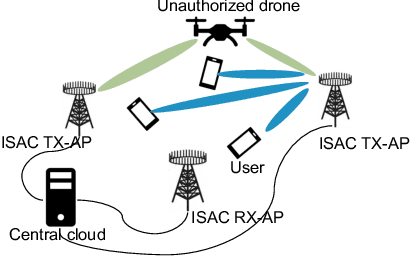
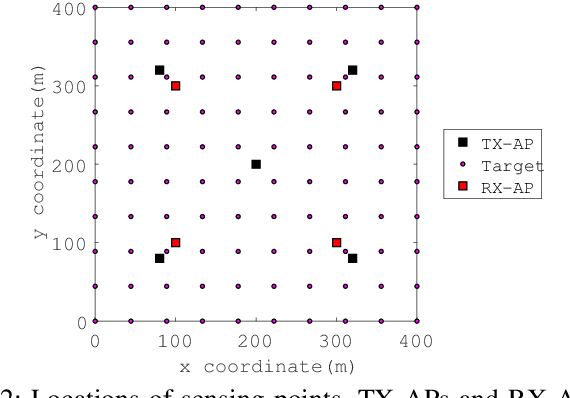

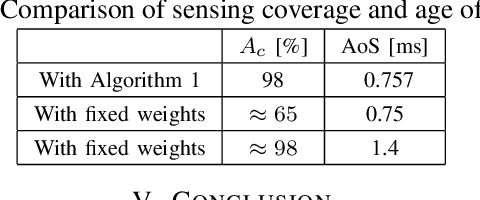
Abstract:Integrated sensing and communication (ISAC) boosts network efficiency by using existing resources for diverse sensing applications. In this work, we propose a cell-free massive MIMO (multiple-input multiple-output)-ISAC framework to detect unauthorized drones while simultaneously ensuring communication requirements. We develop a detector to identify passive aerial targets by analyzing signals from distributed access points (APs). In addition to the precision of the sensing, timeliness of the sensing information is also crucial due to the risk of drones leaving the area before the sensing procedure is finished. We introduce the age of sensing (AoS) and sensing coverage as our sensing performance metrics and propose a joint sensing blocklength and power optimization algorithm to minimize AoS and maximize sensing coverage while meeting communication requirements. Moreover, we propose an adaptive weight selection algorithm based on concave-convex procedure to balance the inherent trade-off between AoS and sensing coverage. Our numerical results show that increasing the communication requirements would significantly reduce both the sensing coverage and the timeliness of the sensing. Furthermore, the proposed adaptive weight selection algorithm can provide high sensing coverage and reduce the AoS by 45% compared to the fixed weights, demonstrating efficient utilization of both power and sensing blocklength.
Energy-Efficient Cell-Free Massive MIMO with Wireless Fronthaul
Dec 03, 2024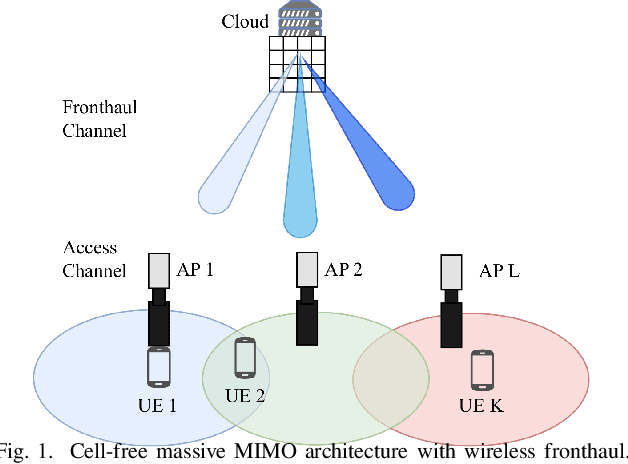
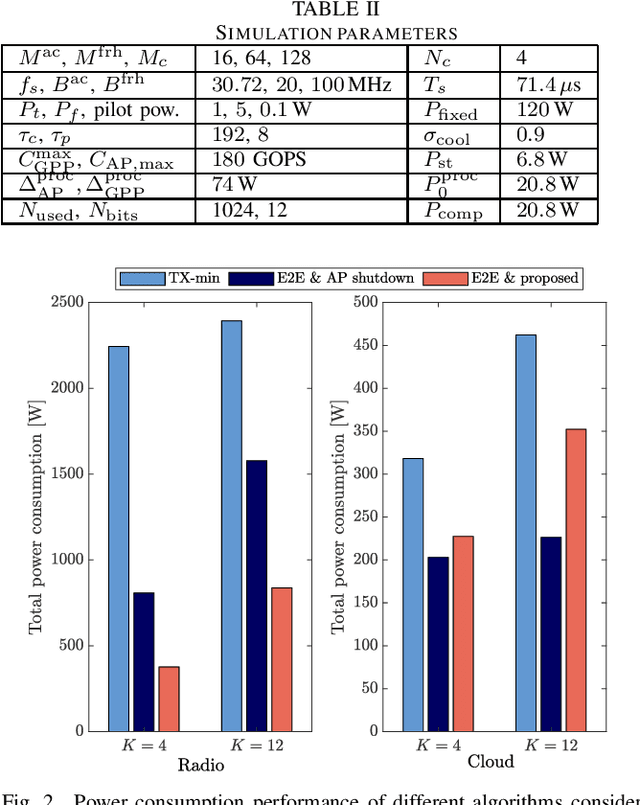
Abstract:Cell-free massive MIMO improves the fairness among the user equipments (UEs) in the network by distributing many cooperating access points (APs) around the region while connecting them to a centralized cloud-computing unit that coordinates joint transmission/reception. However, the fiber cable deployment for the fronthaul transport network and activating all available antennas at each AP lead to increased deployment cost and power consumption for fronthaul signaling and processing. To overcome these challenges, in this work, we consider wireless fronthaul connections and propose a joint antenna activation and power allocation algorithm to minimize the end-to-end (from radio to cloud) power while satisfying the quality-of-service requirements of the UEs under wireless fronthaul capacity limitations. The results demonstrate that the proposed methodology of deactivating antennas at each AP reduces the power consumption by 50% and 84% compared to the benchmarks based on shutting down APs and minimizing only the transmit power, respectively.
Communicate or Sense? AP Mode Selection in mmWave Cell-Free Massive MIMO-ISAC
Dec 03, 2024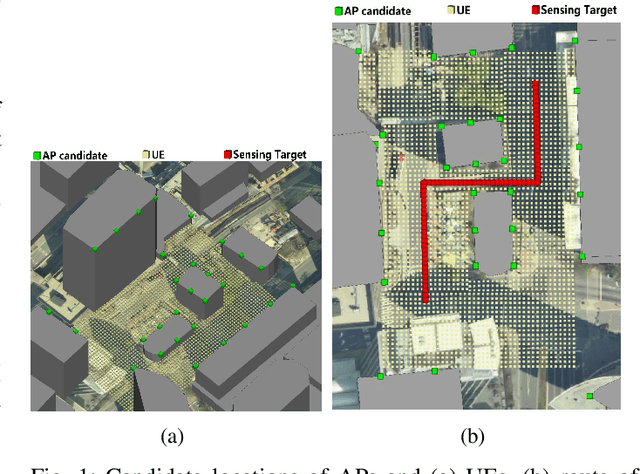
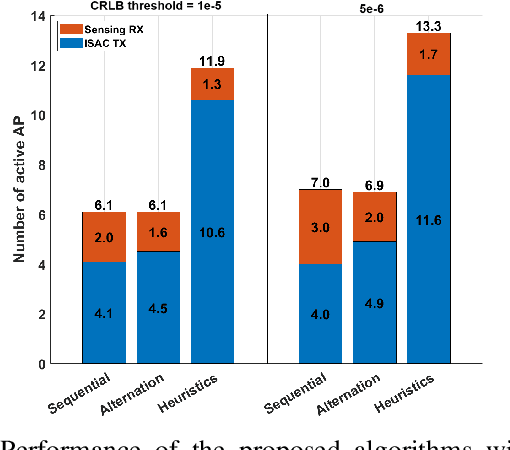

Abstract:Integrated sensing and communication (ISAC) is a promising technology for future mobile networks, enabling sensing applications to be performed by existing communication networks, consequently improving the system efficiency. Millimeter wave (mmWave) signals provide high sensing resolution and high data rate but suffer from sensitivity to blockage. Cell-free massive multiple-input multiple-output (MIMO), with a large number of distributed access points (APs), can overcome this challenge by providing macro diversity against changing blockages and can save energy consumption by deactivating unfavorable APs. Thus, in this work, we propose a joint dynamic AP mode selection and power allocation scheme for mmWave cell-free massive MIMO-ISAC, where APs are assigned either as ISAC transmitters, sensing receivers, or shut down. Due to the large size of the original problem, we propose three different sub-optimal algorithms that minimize the number of active APs while guaranteeing the sensing and communication constraints. Numerical results demonstrate that assigning ISAC transmitters only satisfying communication constraints, followed up by sensing receiver assignment only for sensing constraint achieves the best performance-complexity balance.
Multi-Target Integrated Sensing and Communications in Massive MIMO Systems
Oct 29, 2024Abstract:Integrated sensing and communications (ISAC) allows networks to perform sensing alongside data transmission. While most ISAC studies focus on single-target, multi-user scenarios, multi-target sensing is scarcely researched. This letter examines the monostatic sensing performance of a multi-target massive MIMO system, aiming to minimize the sum of Cram\'er-Rao lower bounds (CRLBs) for target direction-of-arrival estimates while meeting user equipment (UE) rate requirements. We propose several precoding schemes, comparing sensing performance and complexity, and find that sensing-focused precoding with power allocation for communication achieves near-optimal performance with 20 times less complexity than joint precoding. Additionally, time-sharing between communication and sensing outperforms simple time division, highlighting the benefits of resource-sharing for ISAC.
 Add to Chrome
Add to Chrome Add to Firefox
Add to Firefox Add to Edge
Add to Edge